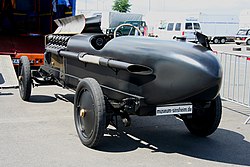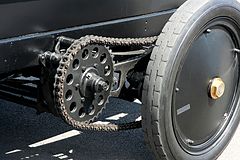Brutus (experimental vehicle)
| Brutus | |
|---|---|

|
|
| Brutus | |
| Presentation year: | 2006 |
| Vehicle fair: | |
| Class : | race car |
| Body shape : | Roadster |
| Engine: |
Otto engine : 47.0 liters (550 kW) |
| Empty weight: | 2537 kg |
| Production model: | none |
Brutus is an experimental racing car designed by the Auto- und Technikmuseum Sinsheim between 1998 and 2006 in the style of corresponding vehicles from the early 20th century. A special feature of this car is a BMW aero engine with a displacement of 47 liters.
engine
As a drive is BMW VI - Aircraft Engine Line 8. It has a displacement of 46,930 cm³ (~ 47 liters) and briefly develops 750 hp (552 kW ) at 1650 rpm. The manufacturer BMW specifies 550 hp (405 kW) at 1530 rpm as the continuous output. The V-engine has 12 cylinders in two rows at an angle of 60 ° to each other with six main and secondary connecting rods each . At the time the engine was designed around 1925, this was a popular design that made it possible to build such a huge engine relatively compactly. Due to the differently articulated connecting rods, the cylinders on the right side each have four liters and on the left side 3.82 liters.
The specific consumption of the engine at full load should be 215–230 g / PSh (292–313 g / kWh).
history
A member of the museum association found the engine in a junkyard in Spain , where it had been lying for decades. Presumably it came from an airplane that flew in the Spanish Civil War . In exchange for another aircraft engine from a Messerschmitt Bf 109 , the engine finally came into the museum's possession via a collector. Originally, the engine was only to be integrated into the exhibition as a further museum piece. To this end, it was given a general technical overhaul in the museum's workshop within four years. At the beginning the exact dimensions of the engine were not known. If you initially assumed "only" about 25 liters displacement, it turned out during the overhaul that it is 47 liters. The director of the museum, Hermann Layher, thought it was a shame to only show the engine alone in the exhibition. So he decided to build the engine into a car. The museum's fund contributed a few missing parts of the engine. Including a matching inertia starter, which was exhibited in a showcase in the museum and which up until now nobody knew exactly what it was originally intended for.
Viewed historically, such a construction is entirely plausible and not uncommon. After the Treaty of Versailles concluded at the end of the First World War , Germany was forbidden from building air forces . But since there were still many aircraft engines available, they were often used in racing cars. The Auto- und Technikmuseum Sinsheim, for example, is also exhibiting a Mercedes 45 PS from 1907, in which a Maybach aircraft engine with 19.5 liters displacement and around 220 kW (299 PS) was installed as early as 1917 .
The Brutus was introduced in 2006. It took about eight years to build, with four years being spent on overhauling the engine.
construction
The chassis of an American LaFrance fire engine from 1908 serves as the chassis. The engine power is transmitted to the rear axle via the original gearbox with three gears and a chain transmission. An intermediate gear was installed between the engine and the gearbox to adapt it to the low-lying crankshaft. As a counterweight to the heavy engine, the several hundred liter tank is housed in the rear. The brakes only act on the rear axle. The body was made in the workshop of the Auto & Technik Museum Sinsheim, in which a group of enthusiasts who called themselves Brutus-Motorwagenbau also built the entire vehicle. The car has no bulkhead ; the driver sits directly behind the engine, whose moving parts (for example the flywheel ) are only separated from the driver's compartment by a grille. The driver is exposed more or less directly and without protection to the hot waste heat and any leaks in the engine.
The Brutus weighs 2537 kg empty.
Mileage
The original goal was to use the Brutus to construct a car that could reach a speed of 100 km / h at a speed of 800 rpm . The engine idling speed is 400 rpm.
The Brutus reached speeds between 120 and 140 km / h several times. The Welshman Roger Collings achieved a top speed of 200 km / h during test drives in Boxberg in 2007 and 2008 . According to the test drivers, there is still plenty of power reserves for much higher speeds.
Surname
The name "Brutus" is an allusion to Marcus Junius Brutus , who was involved in the collective murder of Julius Caesar . Caesar was Brutus' mentor, foster father and, in a sense, his boss. Hermann Layher is convinced that the Brutus racing car is definitely the most dangerous vehicle in the world and is always out to want to kill its driver, i.e. its boss.
Web links
Individual evidence
- ↑ a b c d e Hans-Jörg Götzl: Brutus pre-war car. In: Hell machine with V12 aircraft engine. Motor-Klassik.de, July 12, 2009, accessed on May 11, 2011 .
- ↑ Auto and Technology Museum Sinsheim. (No longer available online.) In: Brutus Experimental Vehicle. Auto- und Technikmuseum Sinsheim, archived from the original on May 11, 2011 ; Retrieved May 11, 2011 .
- ↑ a b Tom Greenway: Oldtimer project Brutus. In: racing car with aircraft engine. Spiegel Online, May 5, 2011, accessed May 11, 2011 .
- ↑ a b Brutus project. In: For the ride on the cannonball. Focus Online, May 9, 2011, accessed May 11, 2011 .
- ↑ Auto and Technology Museum Sinsheim. (No longer available online.) In: Maybach mit Flugzeugmotor. Auto- und Technikmuseum Sinsheim, archived from the original on May 22, 2011 ; Retrieved May 11, 2011 .
- ^ A b American La France "Brutus". Traumautoarchiv.de, March 29, 2011, accessed on May 11, 2011 .
- ↑ Own spelling of the museum . Retrieved July 22, 2015.
- ↑ Information on the exhibit plate in the museum and on the type plate on the vehicle.
- ↑ Brutus experimental vehicle | Technology Museum Sinsheim. Retrieved March 29, 2020 .


